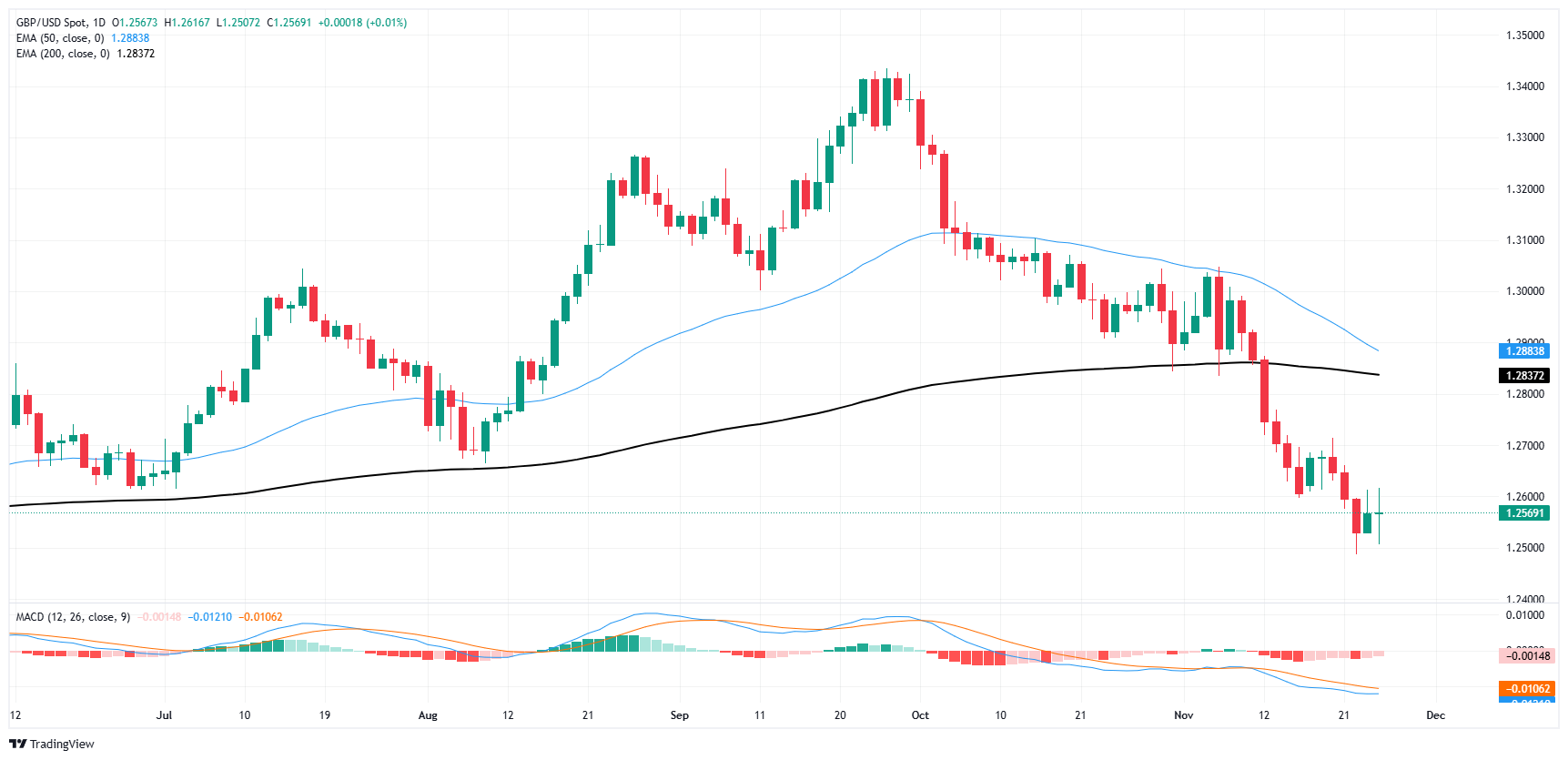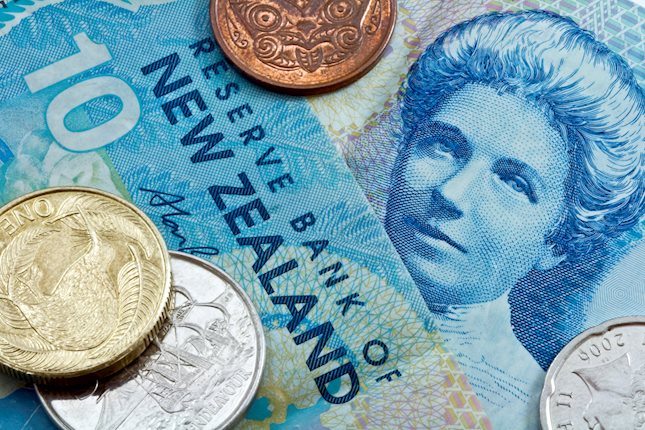- GBP/USD waffled just below the 1.2600 handle on Tuesday.
- Pound Sterling bidders remain elusive amid data-light schedule.
- Overall market sentiment is twisting ahead of key US inflation figures.
GBP/USD churned chart paper just below 1.2600 on Tuesday, marking out familiar territory as the Pound Sterling struggles to find an intraday direction against the Greenback. A limited data schedule on either side of the Atlantic kept Cable traders locked in place, but looming US inflation data could spark a fresh round of volatility ahead of the US Thanksgiving holiday slated for Thursday.
A raft of financial activity figures from the UK are slated for release on Friday, but the figures are broadly low-tier and will have a limited impact. Some particularly-studious Pound Sterling traders will be keeping one eye on the Bank of England’s latest Financial Stability Report, also due Friday, but market movement is likely to be limited from the print.
Wednesday will bring another update to US Personal Consumption Expenditure Price Index (PCEPI) inflation, a key reading of price increases underpinning the US economy. Wednesday also brings a quarterly update of US Gross Domestic Product (GDP) growth. Annualized core PCEPI inflation is set to accelerate again in October and forecast to increase to 2.8% from the previous 2.7%. QoQ US GDP growth in the third quarter is expected to hold steady at 2.8%.
GBP/USD price forecast
GBP/USD remains hobbled on the south side of the 1.2600 handle, churning bids north of 1.2500 as the pair finds some breathing room after another leg lower from early November’s choppy plateau just below 1.3000. Cable reached a six-month low of 1.2487 late last week, clipping into a 7% decline top-to-bottom from September’s peaks at 1.3434.
In the near-term, Pound bulls hoping for an end to the current Greenback upshot will be looking for intraday bids to return to the 200-day Exponential Moving Average (EMA) near 1.2840, while long-run short positions will be looking for an opportunity to redevelop momentum and drag Cable back to 2024 lows at the 1.2300 handle.
GBP/USD daily chart
Pound Sterling FAQs
The Pound Sterling (GBP) is the oldest currency in the world (886 AD) and the official currency of the United Kingdom. It is the fourth most traded unit for foreign exchange (FX) in the world, accounting for 12% of all transactions, averaging $630 billion a day, according to 2022 data. Its key trading pairs are GBP/USD, also known as ‘Cable’, which accounts for 11% of FX, GBP/JPY, or the ‘Dragon’ as it is known by traders (3%), and EUR/GBP (2%). The Pound Sterling is issued by the Bank of England (BoE).
The single most important factor influencing the value of the Pound Sterling is monetary policy decided by the Bank of England. The BoE bases its decisions on whether it has achieved its primary goal of “price stability” – a steady inflation rate of around 2%. Its primary tool for achieving this is the adjustment of interest rates. When inflation is too high, the BoE will try to rein it in by raising interest rates, making it more expensive for people and businesses to access credit. This is generally positive for GBP, as higher interest rates make the UK a more attractive place for global investors to park their money. When inflation falls too low it is a sign economic growth is slowing. In this scenario, the BoE will consider lowering interest rates to cheapen credit so businesses will borrow more to invest in growth-generating projects.
Data releases gauge the health of the economy and can impact the value of the Pound Sterling. Indicators such as GDP, Manufacturing and Services PMIs, and employment can all influence the direction of the GBP. A strong economy is good for Sterling. Not only does it attract more foreign investment but it may encourage the BoE to put up interest rates, which will directly strengthen GBP. Otherwise, if economic data is weak, the Pound Sterling is likely to fall.
Another significant data release for the Pound Sterling is the Trade Balance. This indicator measures the difference between what a country earns from its exports and what it spends on imports over a given period. If a country produces highly sought-after exports, its currency will benefit purely from the extra demand created from foreign buyers seeking to purchase these goods. Therefore, a positive net Trade Balance strengthens a currency and vice versa for a negative balance.
Information on these pages contains forward-looking statements that involve risks and uncertainties. Markets and instruments profiled on this page are for informational purposes only and should not in any way come across as a recommendation to buy or sell in these assets. You should do your own thorough research before making any investment decisions. FXStreet does not in any way guarantee that this information is free from mistakes, errors, or material misstatements. It also does not guarantee that this information is of a timely nature. Investing in Open Markets involves a great deal of risk, including the loss of all or a portion of your investment, as well as emotional distress. All risks, losses and costs associated with investing, including total loss of principal, are your responsibility. The views and opinions expressed in this article are those of the authors and do not necessarily reflect the official policy or position of FXStreet nor its advertisers. The author will not be held responsible for information that is found at the end of links posted on this page.
If not otherwise explicitly mentioned in the body of the article, at the time of writing, the author has no position in any stock mentioned in this article and no business relationship with any company mentioned. The author has not received compensation for writing this article, other than from FXStreet.
FXStreet and the author do not provide personalized recommendations. The author makes no representations as to the accuracy, completeness, or suitability of this information. FXStreet and the author will not be liable for any errors, omissions or any losses, injuries or damages arising from this information and its display or use. Errors and omissions excepted.
The author and FXStreet are not registered investment advisors and nothing in this article is intended to be investment advice.
Recommended content
Editors’ Picks

NZD/USD jumps toward 0.5900 after RBNZ interest rate decision
NZD/USD has picked up fresh bids, marching toward 0.5900 early Wednesday. The New Zealand Dollar finds fresh buyers after the RBNZ announced 50 bps interest rate cut to 4.25%, as widely expected. Kiwi buyers shrug off dovish guidance by the RBNZ.

USD/JPY stays pressured below 153.00, US data eyed
USD/JPY slides to over a two-week low below 153.00 early Wednesday as Trump's tariff threats continue to drive haven flows towards the JPY and exert pressure on spot prices. That said, doubts over the BoJ's ability to tighten its monetary policy further should cap gains for the JPY. US data eyed.

Gold price consolidates amid mixed cues; holds comfortably above $2,600
Gold price struggles to capitalize on the overnight bounce from the $2,600 neighborhood or over a one-week low and trades with a mild negative bias on Wednesday. The prevalent risk-on environment, expectations for a less dovish Fed, elevated US bond yields and the underlying bullish sentiment surrounding the USD act as a headwind for the commodity.

Bitcoin remains short of $100K as long-term holders capitalize on recent price rise
Bitcoin (BTC) trades below $95K on Tuesday following increased selling pressure among long-term holders (LTH) after a series of new all-time highs (ATH).

Eurozone PMI sounds the alarm about growth once more
The composite PMI dropped from 50 to 48.1, once more stressing growth concerns for the eurozone. Hard data has actually come in better than expected recently – so ahead of the December meeting, the ECB has to figure out whether this is the PMI crying wolf or whether it should take this signal seriously. We think it’s the latter.

Best Forex Brokers with Low Spreads
VERIFIED Low spreads are crucial for reducing trading costs. Explore top Forex brokers offering competitive spreads and high leverage. Compare options for EUR/USD, GBP/USD, USD/JPY, and Gold.